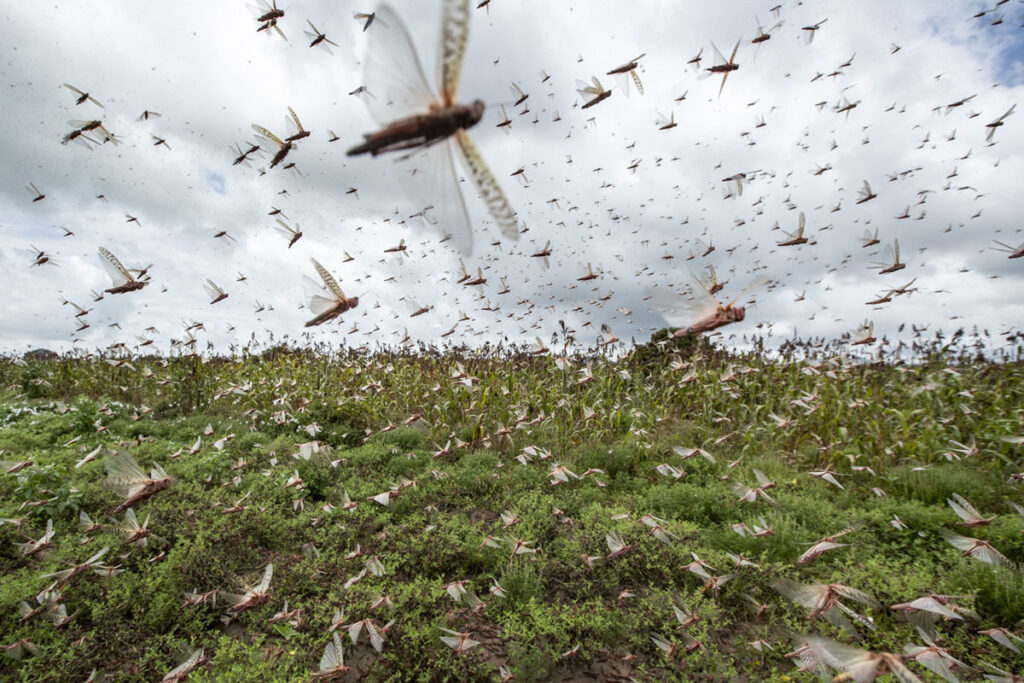Worst Locust Swarm to Hit East Africa in Decades Linked to Climate Crisis
AFRICA, 3 Feb 2020
Olivia Rosane | EcoWatch – TRANSCEND Media Service

Swarms of desert locusts fly up into the air from crops in Katitika village, Kitui county, Kenya Friday, Jan. 24, 2020. Desert locusts have swarmed into Kenya by the hundreds of millions from Somalia and Ethiopia, countries that haven’t seen such numbers in a quarter-century, destroying farmland and threatening an already vulnerable region. (AP Photo/Ben Curtis)
27 Jan 2020 – East Africa is facing its worst locust infestation in decades, and the climate crisis is partly to blame.
The UN’s Food and Agricultural Organization (FAO) said that Ethiopia and Somalia had not seen a swarm this bad in 25 years, while Kenya was facing its largest infestation in 70 years, BBC News reported.
“Vulnerable families that were already dealing with food shortages now face the prospect of watching as their crops are destroyed before their eyes,” UN humanitarian chief Mark Lowcock told Kenya’s Capital News.
Over 11 million people in Kenya, Ethiopia & Somalia already suffer from acute food insecurity. #Locusts are threatening to make it a lot worse.
It is critical that we anticipate potential deterioration.
— @FAO @dburgeon is on the ground in Lengusaka, Kenya@FAOemergencies pic.twitter.com/2SvbTdX0NV
— Food and Agriculture Organization (@FAO) January 24, 2020
The desert locust swarm came across the Red Sea from Yemen and was encouraged by heavy rains in late 2019, according to BBC News. The UN was already warning that the infestation could spread from Ethiopia in November. Some farmers in the country’s Amhara region lost 100 percent of their crops, and a swarm forced an Ethiopian passenger plane off course in December.
Locusts can travel 93 miles a day, and each adult can eat its weight in food in the same time span. A small swarm can eat enough food to feed 35,000 people in 24 hours, The Associated Press reported, and the locusts have already infested around 172,973 acres of land in Kenya.
“The speed of the pests’ spread and the size of the infestations are so far beyond the norm that they have stretched the capacities of local and national authorities to the limit,” the FAO said, according to BBC News.
The unusual size of the swarms is connected to the climate crisis, The Associated Press explained further:
Heavy rains in East Africa made 2019 one of the region’s wettest years on record, said Nairobi-based climate scientist Abubakr Salih Babiker. He blamed rapidly warming waters in the Indian Ocean off Africa’s eastern coast, which also spawned an unusual number of strong tropical cyclones off Africa last year.
Heavy rainfall and warmer temperatures are favorable conditions for locust breeding and in this case the conditions have become “exceptional,” he said.
Rainy conditions expected in March could cause the locust swarms to grow by a factor of 500 before drier weather is expected in June, the UN said.
Now, authorities are working to control the infestation by spraying pesticides from the air. The UN funneled $10 million towards the spraying Wednesday, but said that $70 million was needed to spray sufficiently.
“This one, ai! This is huge,” Kipkoech Tale, a migratory pest control specialist with the Kenyan agriculture ministry, told The Associated Press. “I’m talking about over 20 swarms that we have sprayed. We still have more. And more are coming.”
______________________________________________
More:
- In Pictures: Locust outbreak spreads across East Africa | | Al Jazeera ›
- East Africa’s battles devastating locust swarms – BBC News ›
- Major Locust Swarm Is an ‘Unprecedented Threat’ to East Africa ›
- ‘This is huge’: Locust swarms in Africa are worst in decades ›
Olivia Rosane is a freelance reporter for EcoWatch.
Tags: Africa, Agriculture, Environment
DISCLAIMER: The statements, views and opinions expressed in pieces republished here are solely those of the authors and do not necessarily represent those of TMS. In accordance with title 17 U.S.C. section 107, this material is distributed without profit to those who have expressed a prior interest in receiving the included information for research and educational purposes. TMS has no affiliation whatsoever with the originator of this article nor is TMS endorsed or sponsored by the originator. “GO TO ORIGINAL” links are provided as a convenience to our readers and allow for verification of authenticity. However, as originating pages are often updated by their originating host sites, the versions posted may not match the versions our readers view when clicking the “GO TO ORIGINAL” links. This site contains copyrighted material the use of which has not always been specifically authorized by the copyright owner. We are making such material available in our efforts to advance understanding of environmental, political, human rights, economic, democracy, scientific, and social justice issues, etc. We believe this constitutes a ‘fair use’ of any such copyrighted material as provided for in section 107 of the US Copyright Law. In accordance with Title 17 U.S.C. Section 107, the material on this site is distributed without profit to those who have expressed a prior interest in receiving the included information for research and educational purposes. For more information go to: http://www.law.cornell.edu/uscode/17/107.shtml. If you wish to use copyrighted material from this site for purposes of your own that go beyond ‘fair use’, you must obtain permission from the copyright owner.